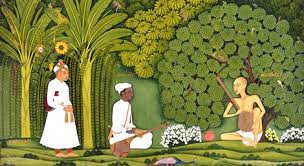Dhrupad is one of the oldest forms of Indian classical music. It carries a rich legacy that dates back centuries. It is rooted in ancient scriptures and traditions. In this article, we explore the essence of Dhrupad, its unique features, and its enduring significance in the world of music.

Dhrupad is a classical vocal genre that originated in medieval India. Its name is derived from “Dhruva,” meaning steadfast, and “Pada,” meaning verse. It is characterized by its majestic and meditative style, emphasizing long, sustained notes, intricate rhythmic patterns, and elaborate melodic improvisations. It is performed in a highly disciplined manner, adhering to specific rules of presentation and composition.
Elements of Dhrupad
- Alap: Dhrupad performances begin with an elaborate Alap, a meditative and introspective exploration of the raga (melodic framework). The Alap sets the mood, gradually unveiling the raga’s essence through a melodic progression devoid of rhythmic accompaniment. It showcases the artist’s mastery of microtonal nuances, creating a serene and introspective ambiance.
- Bandish: The Bandish forms the core of a Dhrupad composition. It consists of poetic verses set to specific melodic patterns called “sthayi” and “antara.” The Bandish is often composed in ancient languages like Sanskrit or Braj Bhasha, and its lyrics are imbued with deep spiritual or devotional themes.
- Nomtom: Nomtom refers to the rhythmic section of a Dhrupad performance. It features intricate patterns and syllables sung in a rhythmic cycle, highlighting the artist’s skill in precise and complex rhythmic improvisations. Nomtom sequences exhibit the interplay between the vocalist and accompanying percussion instruments like the pakhawaj or tabla.
Significance
Dhrupad holds a special place in the world of music due to its unique characteristics and cultural heritage. Its profound spiritual and meditative qualities offer listeners a transcendental experience, inviting them on a journey of self-discovery and inner peace. Dhrupad’s emphasis on pristine voice production, meticulous rendition of ragas, and intricate rhythmic patterns make it a challenging yet rewarding art form for performers.
Preserving Tradition
Despite the evolving landscape of music, Dhrupad has remained steadfast in its adherence to tradition. Numerous dedicated gharanas (lineages) have safeguarded and propagated this ancient art form through rigorous training and discipleship. Today, Dhrupad continues to thrive through the efforts of talented artists and organizations, ensuring its preservation for future generations.
Conclusion
It stands as a timeless treasure within the realm of Indian classical music, captivating enthusiasts with its divine melodies and intricate rhythms. Its mesmerizing allure lies in the seamless blend of spiritual depth, technical brilliance, and artistic expression. Through its melodic tapestry, Dhrupad invites listeners to embark on a transformative journey, connecting with the profound emotions and spiritual essence of the music.
Q. With reference to Dhrupad, one of the major traditions of India that has been kept alive for centuries, which of the following statements are correct?
1. Dhrupad originated and developed in the Rajput kingdoms during the Mughal period.
2. Dhrupad is primarily a devotional and spiritual music.
3. Dhrupad Alap uses Sanskrit syllables from Mantras.
Select the correct answer using the codes given below :
(a) 1 and 2 only
(b) 2 and 3 only
(c) 1, 2 and 3
(d) None of the above is correct
UPSC Prelims 2012
Ans: (b)
Important Links